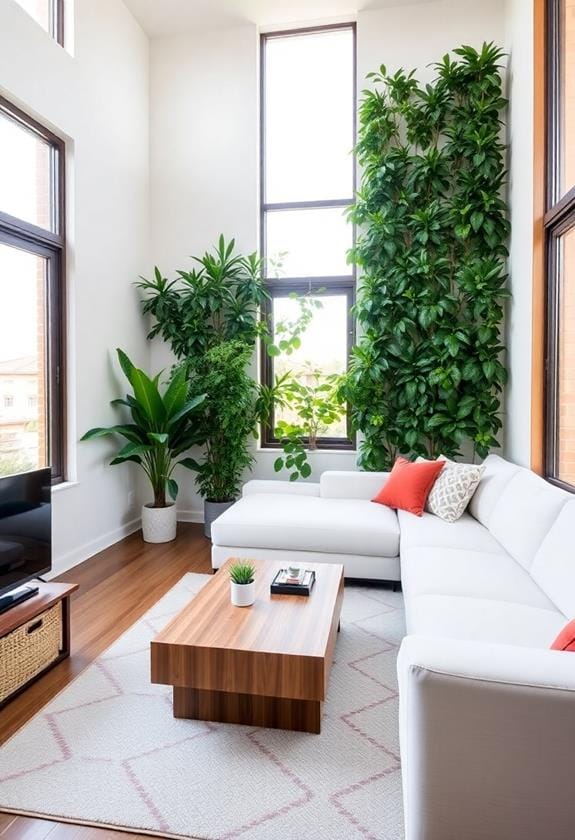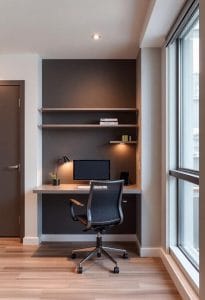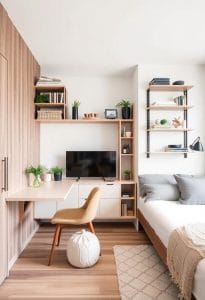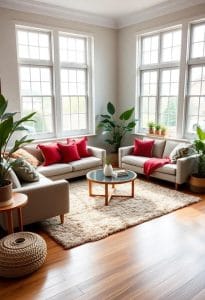To transform small spaces with minimalist design, begin by optimizing vertical storage using shelves and wall-mounted racks to free up floor space. Choose multifunctional furniture, such as a sofa that converts into a bed, to enhance utility. Embrace a neutral color palette, allowing light tones to evoke openness and cohesion. Mirrors strategically placed can expand visual boundaries, while hidden storage solutions, like ottomans with compartments, keep clutter at bay. Simplify your decor by selecting meaningful pieces that serve dual purposes. Finally, prioritize natural light by using sheer curtains and placing mirrors to reflect sunlight. Discover how these ideas can redefine your space.
Key Points
- Utilize vertical storage with wall-mounted racks and tall cabinets to maximize floor space.
- Choose multifunctional furniture like sofas that convert into beds for dual purposes.
- Embrace a limited neutral color palette to create a cohesive and airy atmosphere.
- Enhance space with strategically placed mirrors to reflect light and expand visual boundaries.
- Keep decor simple and intentional, focusing on key pieces to avoid clutter.
Optimize Vertical Storage
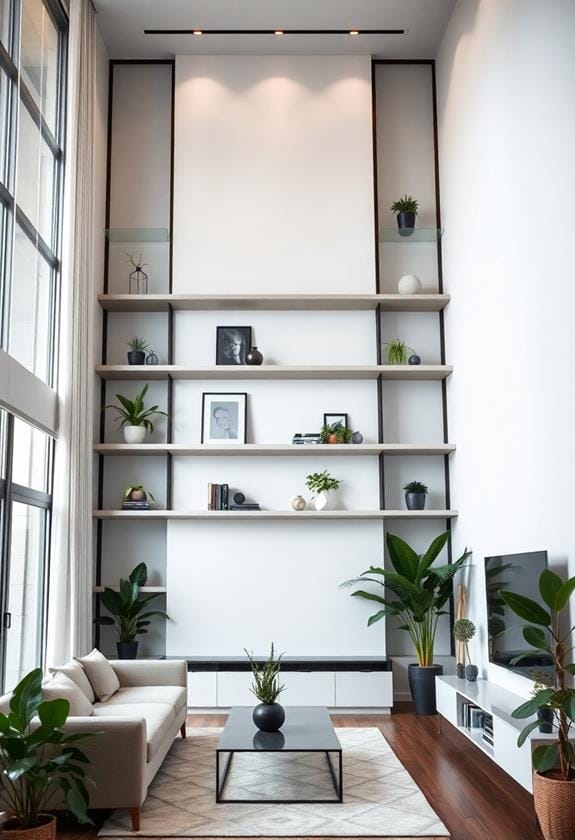
How can you make the most of your small space? One effective strategy is optimizing vertical storage. In tight spaces, it's essential to think beyond traditional horizontal layouts. Look up and utilize your walls to store and organize efficiently. Start by installing shelves that reach up to the ceiling, creating room for books, decorative items, or even kitchenware. This guarantees that every inch of your space is put to good use. Additionally, consider innovative vertical storage ideas like wall-mounted racks or pegboards for items like utensils, tools, or jewelry. These solutions not only save space on counters and tables but also add a touch of personality to your décor. Another tip is to use tall bookcases or cabinets. They provide ample storage without consuming valuable floor space.
Don't forget about over-the-door organizers, which can hold anything from shoes to cleaning supplies. They're perfect for utilizing often-overlooked spaces. Hooks are also your friend; place them strategically for coats, bags, or hats. Remember, the goal is to draw the eye upward, making your room feel larger and more open. By focusing on vertical storage, you maximize your space while maintaining a minimalist, clutter-free environment.
Choose Multifunctional Furniture
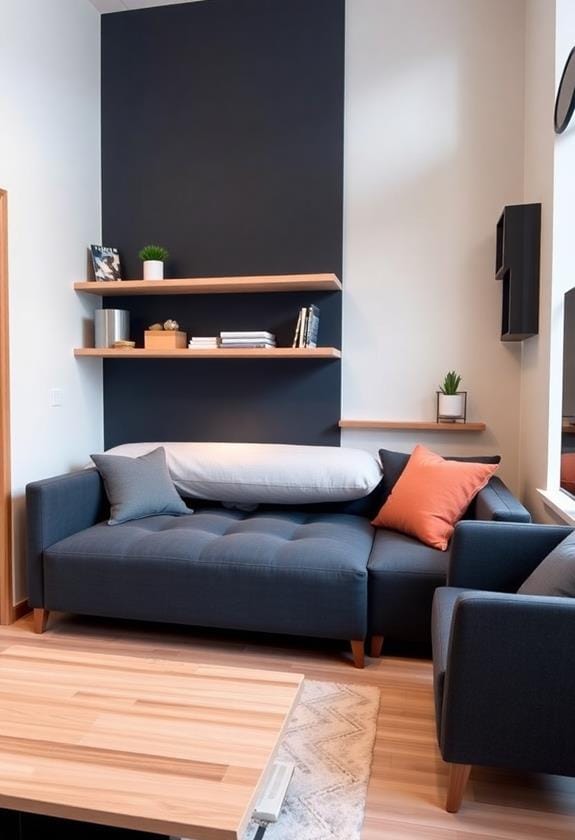
When you're working with limited square footage, multifunctional furniture can be a game-changer. It maximizes your space, offering practicality without sacrificing style. Think about a sofa that transforms into a bed, or a coffee table with hidden storage. These pieces serve dual purposes, allowing you to make the most of every square inch. Consider incorporating light colors to create an airy atmosphere, enhancing the perception of space in small areas.
Consider a dining table that doubles as a desk, perfect for small apartments where you need to optimize space. Similarly, a storage ottoman can provide both a place to sit and a spot to tuck away blankets or magazines. These clever solutions keep your home tidy and organized, which is essential in minimalist design.
Look for furniture with clean lines and simple designs, as they blend well into any room without overwhelming it. A wall-mounted desk can be folded away when not in use, freeing up floor space. You might also explore modular furniture, which can be rearranged to suit your needs. By choosing multifunctional pieces, you create a versatile living space that adapts to your lifestyle, ensuring comfort and functionality in even the smallest areas. Your home becomes an efficient, harmonious environment.
Embrace Neutral Color Palettes

Multifunctional furniture sets the stage for a minimalist aesthetic, but embracing neutral color palettes truly elevates your small space. Neutral tones like whites, beiges, and grays create an open, airy atmosphere, making rooms feel larger and more serene. These colors reflect light, brightening your space and enhancing its natural features. By choosing a neutral palette, you allow your furniture and decor to coexist harmoniously, creating a cohesive look without overwhelming the senses. Incorporating Scandinavian Minimalism can further enhance this approach, as it emphasizes simplicity and functionality, perfectly suited for small spaces.
When you opt for neutral colors, you also introduce versatility into your decor. These shades serve as a timeless backdrop, allowing you to easily switch out accents or seasonal decorations without clashing. This adaptability is especially beneficial in small spaces where each piece must work seamlessly with the rest. You can add warmth and texture through soft furnishings like throw pillows or rugs, in complementary shades or subtle patterns, to prevent the space from feeling too stark.
Embracing a neutral palette doesn't mean your room has to be bland. Use varying textures and materials like wood, metal, or linen to add depth and interest. This approach keeps your small space visually engaging, without sacrificing the minimalist essence.
Use Mirrors to Create Depth
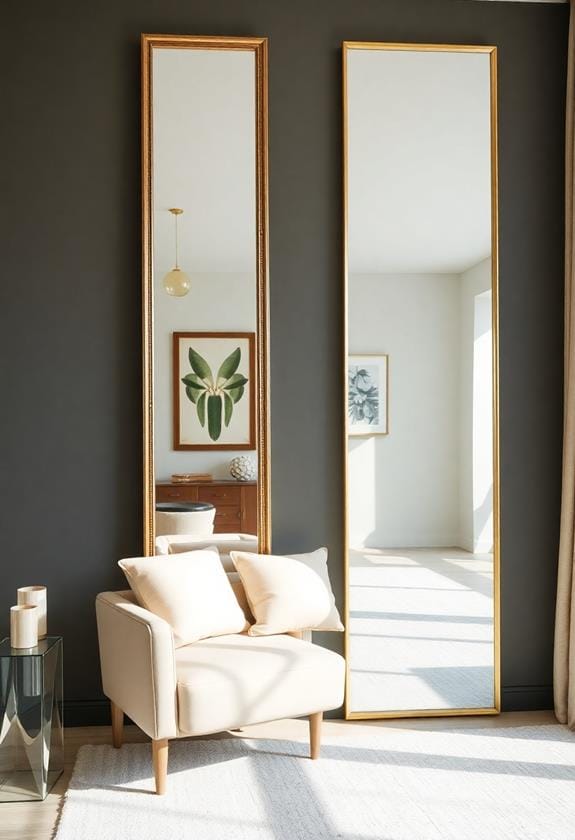
To transform your small space into a more expansive and inviting environment, consider strategically using mirrors. Mirrors have the remarkable ability to reflect light, creating an illusion of depth and openness that can make even the tiniest rooms feel larger. Pairing mirrors with stylish lighting solutions can further enhance this effect, as both elements work together to amplify light and create a more inviting atmosphere. By placing mirrors opposite windows or light sources, you can amplify natural light, making the space appear brighter and more welcoming. This simple trick can dramatically change the ambiance of the room, giving it a fresh and airy vibe.
When selecting mirrors, think about their placement and size. A large mirror on one wall can act as a focal point, drawing the eye and expanding the room's visual boundaries. Alternatively, a series of smaller mirrors arranged artfully can add a touch of creativity while still serving the purpose of enhancing depth. Consider using mirrors with minimalistic frames to maintain a clean, uncluttered look, aligning with the principles of minimalist design.
Incorporate Hidden Storage Solutions
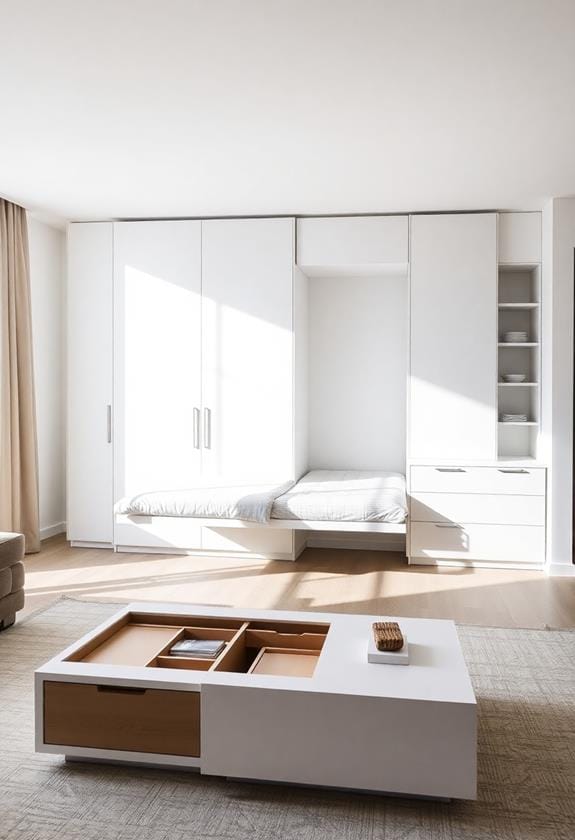
Beyond using mirrors to expand your space visually, you can maximize functionality by incorporating hidden storage solutions. Small spaces often require creativity, and hidden storage offers a clever way to keep your belongings organized without cluttering your environment. Consider furniture pieces with built-in storage, like ottomans or beds with drawers underneath, which provide ample space to stow away items you don't need every day. This not only keeps your room tidy but also maintains a minimalist aesthetic. Additionally, you might explore efficient small bedroom organization tips to enhance your room's functionality. Wall-mounted shelves with concealed compartments are another excellent option. They allow you to display decorative items while keeping personal belongings out of sight. You might also think about incorporating multi-functional furniture, such as a coffee table that opens up to reveal storage space or a bench that doubles as a shoe rack. These pieces are perfect for efficiently utilizing every inch of your room.
Keep Decor Simple and Sparse
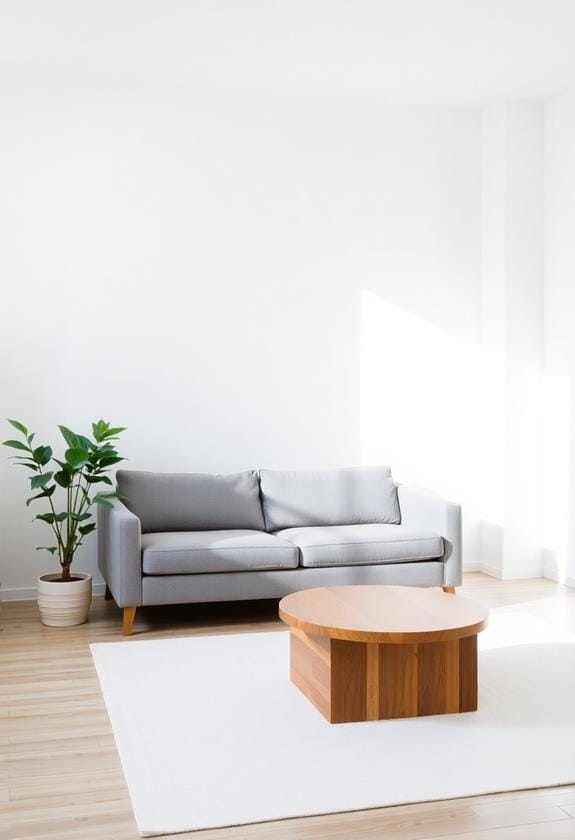
Achieving a minimalist look in small spaces often starts with keeping decor simple and sparse. It's about embracing open areas and letting your room breathe, which can make even the tiniest area feel more expansive. Incorporating minimalist design ideas can also enhance your space's functionality and aesthetic appeal. You want to focus on selecting a few key pieces that add character without overwhelming the space. Think about how each item contributes to the overall aesthetic, and eliminate anything that doesn't serve a purpose or bring you joy. Consider visiting a website that sells products related to minimalist design ideas for small spaces for inspiration.
- Choose functional decor: Opt for pieces that do double duty, like a mirror that adds light and serves as wall art.
- Embrace negative space: Don't feel the need to fill every corner. Empty areas can actually enhance the feeling of spaciousness.
- Limit color palette: Stick to neutral tones or a monochrome scheme to create harmony and avoid visual clutter.
- Curate carefully: Select art and accessories with intention. A single statement piece can be more impactful than an assortment of smaller items.
Prioritize Natural Light
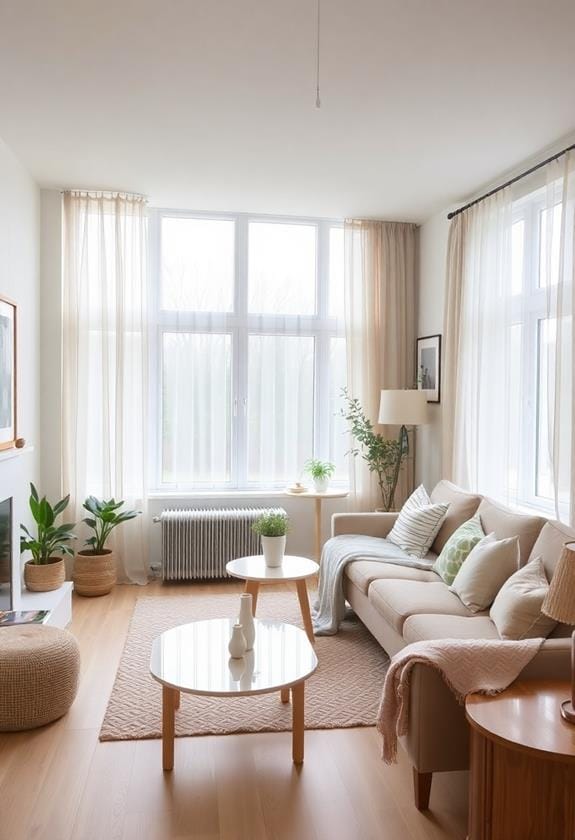
Flooding your space with natural light is essential for achieving a minimalist design in small areas. When you allow sunlight to pour in, it instantly makes the room feel larger and more open. Start by removing heavy drapes or curtains, opting instead for sheer fabrics or blinds that can be easily adjusted. This not only increases brightness but also maintains your privacy without compromising on light. Consider incorporating light colors for walls and furniture to further amplify the natural light effect, as they reflect more light than darker shades. This enhances the airy atmosphere and complements the minimalist aesthetic. Consider the placement of mirrors strategically across from windows to reflect light, making your space feel even bigger. Mirrors can act as an extra window, doubly serving the minimalist aesthetic by adding depth without clutter. Keep window sills clear of unnecessary items, letting light cascade uninterrupted into your room.
Choosing lighter colors for your walls and furniture can further amplify the natural light effect. Whites, light grays, and creams reflect more light than darker shades, enhancing the airy atmosphere. If privacy is a concern, consider frosted glass or window films that diffuse light while keeping prying eyes at bay.
Frequently Asked Questions
How Can I Make a Small Space Feel More Spacious Without Renovating?
You can make your small space feel more spacious by thinking outside the box. Start by decluttering, as a tidy area instantly opens up the room. Use mirrors strategically to reflect light, creating an illusion of depth. Opt for furniture with legs to expose the floor, which gives a sense of openness. Light, neutral colors on walls and furniture can also brighten the area, making it feel airy and inviting without any renovations.
What Are Some Minimalist Design Tips for Maximizing a Studio Apartment?
To maximize your studio apartment, start by choosing multifunctional furniture, like a bed with storage underneath or a fold-out desk. Use mirrors strategically to reflect light, making the space feel larger. Stick to a neutral color palette, which creates a calm, open atmosphere. Keep decorations minimal and opt for closed storage to hide clutter. Finally, create distinct areas for living, sleeping, and working with rugs or furniture arrangements to enhance functionality.
How Do I Maintain a Minimalist Lifestyle in a Small Living Area?
Maintaining a minimalist lifestyle in a small living area involves thoughtful curation and discipline. Start by regularly decluttering, ensuring each item serves a purpose or brings joy. Invest in multi-functional furniture, such as a sofa bed or a foldable desk, to maximize space. Keep your color palette neutral to create a sense of openness. Use vertical storage solutions, like shelves or wall hooks, to free up floor space, and stay committed to simplicity.
What Are Budget-Friendly Minimalist Design Ideas for Small Homes?
Contrasting clutter with simplicity, you can transform your small home affordably. Start by choosing multifunctional furniture, like a sofa bed or a folding table, maximizing both space and utility. Embrace neutral colors, which can make rooms feel more open. Add shelves vertically for extra storage, avoiding bulky cabinets. Opt for minimalist decor, using a few select pieces to create a serene environment. Focus on quality over quantity, ensuring every item serves a purpose.
How Can I Incorporate Plants Into a Minimalist Small Space Design?
To incorporate plants into your minimalist small space, focus on selecting low-maintenance varieties like succulents or snake plants, which thrive with minimal attention. Use vertical space by installing wall-mounted planters or hanging pots, keeping surfaces clutter-free. Opt for simple, uniform pots to maintain a cohesive look. Group plants in odd numbers for visual interest, and position them near natural light sources, ensuring they add a touch of nature without overwhelming the minimalist aesthetic.

